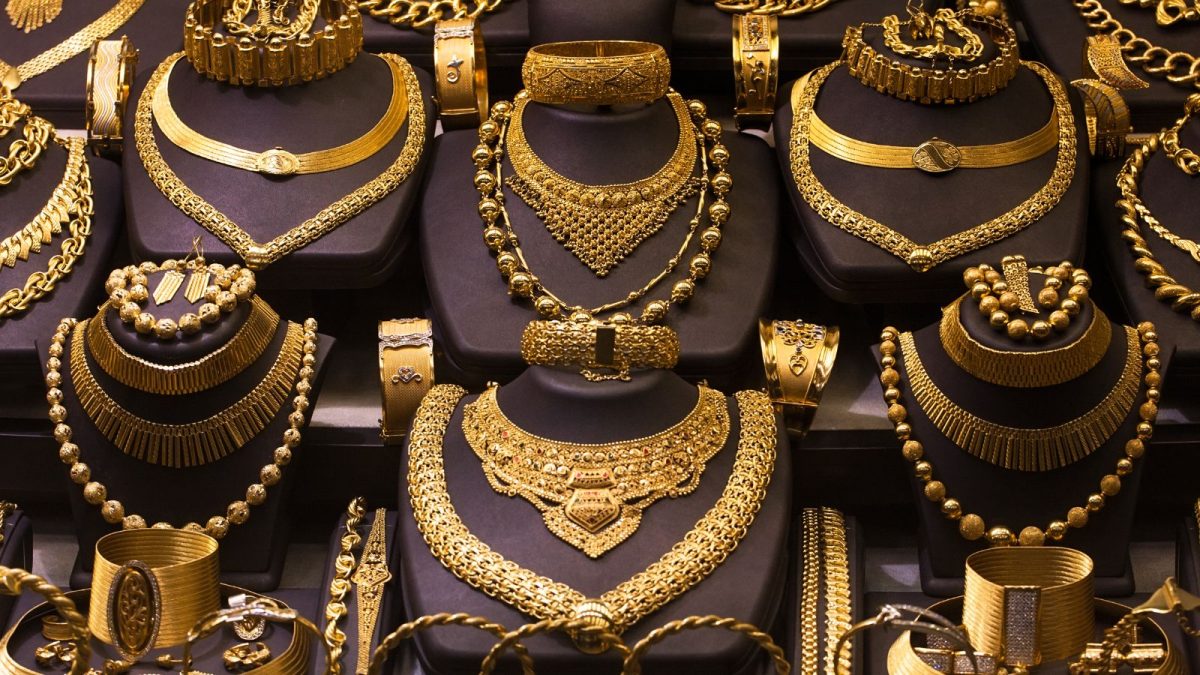Last Updated:
Urban professionals in Bengaluru, Chennai and Mumbai are pledging jewellery at pawn shops and banks for quick, low-interest loans, making gold a new middle-class safety net.

Gold, long considered a family’s safety net, is once again proving its worth, this time not in rural villages but in city neighborhoods and startup hubs. (Image: X)
Pawn shops in Indian cities are reporting something unusual. Alongside their traditional clientele, more young professionals are now walking in with jewellery to pledge for short-term loans. This isn’t the classic picture of an indebted family forced to part with their heirlooms.
Rather, it is urban salaried workers and small business owners treating jewellery as an instant line of credit. A bangle, a necklace, or even a small gold coin can now unlock quick cash, helping people tide over temporary gaps in their finances.
Recommended Stories
It has become a quiet but steady phenomenon, sometimes described as the “gold rush at homes.” The logic is simple: gold lying idle in lockers is converted into cash when needed, then redeemed later. The process has a speed and simplicity that credit cards and bank loans often lack.
Why Jewellery is Becoming a Middle-Class Safety Net
For many households, jewellery has always been an investment disguised as ornament. While it is treasured during weddings and festivals, it has also been the fallback option in a financial crisis. What is new is the profile of borrowers.
Well-dressed young professionals, IT employees, and small entrepreneurs are walking into pawn shops and organized gold loan outlets to pledge their jewellery for short-term credit.
The main attraction is speed. Unlike personal loans from banks, which require income proofs, credit checks, and days of processing, a pawn shop transaction is straightforward. The jewellery is tested for purity, weighed, and valued. Within an hour, the borrower can walk out with cash.
For someone facing an unexpected medical bill, car repair, or even a shortfall before paying rent, the convenience outweighs the emotional discomfort of parting with jewellery, even temporarily.
Why Not Just Use a Credit Card?
The comparison with credit cards is inevitable. Both offer easy access to short-term credit. But there are key differences that explain why some prefer pawn loans.
First, credit card access itself is not universal. Even among young professionals, not everyone qualifies for a high credit limit. Those with patchy credit scores or irregular income find cards harder to get. Jewellery loans bypass that hurdle.
Second, while credit cards offer revolving credit, they come with steep interest charges if payments are delayed. Credit card APRs often cross 30 to 36 percent annually. Gold loans, by comparison, can be far cheaper.
Interest Rates Make the Difference
This is where banks and organized lenders play a big role. Large public and private sector banks now offer gold loans at annual interest rates ranging between 7 to 12 percent.
Some even start lower for existing customers with strong repayment records. NBFCs specializing in gold loans, like Muthoot Finance or Manappuram, usually charge a bit more, anywhere from 12 to 22 percent depending on the scheme and tenure.
Compare this to a personal loan, where interest rates typically start at 10 to 16 percent in banks, and go higher in the case of NBFCs. Or credit cards, which can easily cross 30 percent. Suddenly, pledging gold looks like a smart move.
For a borrower who needs Rs 1 lakh for three months, the difference in total repayment between a gold loan and a credit card bill can be significant.
This cost factor, combined with speed, makes gold loans appealing. For a generation that is still cautious about piling up unsecured debt, using an asset they already own feels like a safer bargain.
The Attractions of Gold-Backed Loans
Pawn shops and gold loan companies highlight several advantages.
- Accessibility: No income proof, no credit score checks, no long application forms.
- Speed: The valuation and disbursal process is often completed within an hour.
- Flexibility: Repayment terms can be negotiated, and borrowers can redeem jewellery whenever they are ready.
- Lower interest than credit cards: With major banks offering single-digit annual rates, gold loans are often the cheapest form of quick credit.
- Trust in gold: Unlike volatile stocks or cryptocurrencies, gold has cultural and economic stability, which makes people comfortable using it as collateral.
These factors explain why urban pawn lending is gaining popularity even among younger demographics who were once considered firmly in the banking fold.
The Risks Hidden in the Glitter
Yet, this trend is not without risks. Interest rates at unorganized pawn shops can be far higher than banks, sometimes running into 20 to 30 percent annually with hidden service charges.
Another concern is valuation. Disputes often arise over the purity of gold or the price applied. Some borrowers feel they are given less than the true value of their jewellery, especially in smaller, unregulated shops. Transparency in testing and weighing is still inconsistent across the market.
The emotional risk is perhaps the most significant. If a borrower cannot repay, the pawn shop has the right to auction or sell the jewellery. For families, losing an item with sentimental or heirloom value can be devastating, even if the cash borrowed was relatively small.
There are also risks for lenders. Cases of fake gold jewellery being pledged have surfaced, forcing shops to be extra cautious. And while gold is a relatively stable asset, sudden falls in international gold prices can reduce the value of collateral, leaving lenders exposed.
A Growing Urban Phenomenon
This gold-backed borrowing is not entirely new. Rural households have long relied on jewellery loans to survive droughts or harvest failures. What is striking today is its urban, middle-class face.
Pawn shops in cities like Bengaluru, Chennai, and Mumbai report more young professionals pawning items discreetly. These are not people at the margins of survival but individuals looking for quick liquidity without the bureaucratic friction of banks.
For some, it is almost becoming a financial habit: pledge when cash runs short, redeem once the next salary or business payment comes in.
Organized lenders are also stepping into this space. Banks and NBFCs specializing in gold loans offer more transparency, digital tracking, and standardized interest rates. Some are experimenting with online gold loan models, where jewellery is collected securely and credit disbursed digitally.
Is This Really the New Middle-Class Credit Card?
The metaphor of the “new middle-class credit card” is tempting, but only partly true. Gold loans and credit cards both provide easy access to money, but they serve different financial instincts.
Credit cards are unsecured credit lines based on trust and creditworthiness. They also build a borrower’s credit history, useful for future loans. Jewellery loans are asset-backed, immediate, and often invisible to credit bureaus. They are more like dipping into one’s own savings than borrowing from a financial institution.
Still, the comparison captures something important. Both represent tools for managing short-term financial stress. Both are widely used by people who need quick cash without complicated processes. And both can become traps if repayment is delayed.
What It Means for Consumers and the Economy
For consumers, the rise of jewellery loans highlights the fragility of household finances. Even salaried professionals are often one emergency away from needing instant liquidity. It also reflects the enduring centrality of gold in India’s financial culture.
For lenders, the trend is an opportunity. Pawn shops, banks, and NBFCs see growing business from demographics they had not traditionally served. But with this opportunity comes responsibility: ensuring fair valuation, transparent charges, and secure handling of pledged items.
For policymakers, it raises questions about consumer protection. Without regulation, there is risk of exploitation through high interest or undervaluation. Bringing pawn lending under clearer frameworks could help both borrowers and lenders.
Conclusion: A Collateral Credit Culture
The rise of gold-backed borrowing among urban professionals is a telling snapshot of India’s middle class today. It shows both resilience and vulnerability — resilience in finding creative ways to unlock wealth, and vulnerability in needing that quick liquidity despite steady incomes.
Gold, long considered a family’s safety net, is once again proving its worth, this time not in rural villages but in city neighborhoods and startup hubs. With major banks offering competitive interest rates and easy processing, pledging jewellery has, for many, become cheaper and simpler than swiping a credit card.
Whether this practice evolves into a regulated, transparent system or remains a patchwork of pawn shops will decide if it truly becomes the middle class’s alternative to the credit card.
October 03, 2025, 12:21 IST
Loading comments…
Stay Ahead, Read Faster
Scan the QR code to download the News18 app and enjoy a seamless news experience anytime, anywhere.

login
Go to Source
Author: News18



